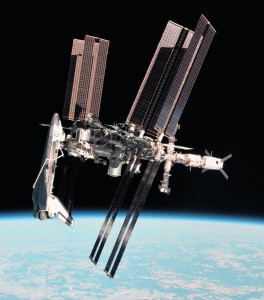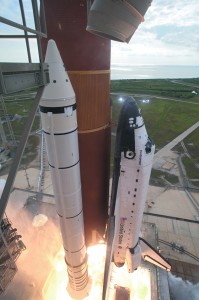MONDAY, 3 OCTOBER 2011
It has been called the most complex machine ever built. It launches as a rocket, orbits as a spacecraft, and lands as a plane. Surviving the frigid cold of space and the furnace of atmospheric re-entry, it protects a crew of eight in one of the most hostile environments imaginable. For those too young to have experienced the moon race, NASA’s space shuttle has been synonymous with the space age. Now, after 30 years of service, the shuttle fleet has been retired following the final flight of Atlantis on the 21st July 2011.Conceived as a weapons system in Cold War America, the idea of a reusable space-plane predates the moon landings. However, kick-started by the launch of Russia’s Sputnik 1 and Yuri Gagarin’s first legendary mission into space, NASA initially sidelined the shuttle in favour of the simpler and cheaper rockets that would bring the US space programme in line with that of its Soviet adversary.
It wasn’t until 1968 that, with the Moon in its grasp, NASA turned its attention away from the Apollo lunar program, and the idea of the space-plane resurfaced. While many questioned the necessity of manned spaceflight once the Moon had been ‘conquered’, President Nixon’s administration eventually gave the shuttle program the green light. In a time of shrinking budgets, its cost-saving fleet of reusable spacecraft would transport the components of space stations and the larger rockets into orbit—ultimately aiming to carry the US to the stars.
However, the Space Shuttle had no precedent. It was originally meant to launch in 1976, but as deadlines passed the reality of developing a fully reusable spaceship became much more complex than anticipated. In fact, the original plans had envisaged two vehicles—the orbiter and a lifting-body that would carry it into space—but it was too heavy and too expensive. The final machine was a compromise, with the orbiter carried into space by the large external tank and two solid rocket boosters that have since become a familiar sight on the launch pads of Florida’s John F. Kennedy Space Centre. It was no longer fully reusable, with the fuel tank discarded after launch, but it was precisely this sort of compromise that allowed the shuttle to exist at all, albeit five years late. In April 1981, on the 20th anniversary of man’s first foray into the cosmos, Columbia finally made the shuttle’s long-anticipated maiden voyage beyond Earth’s atmosphere, returning safely after 54 hours in space.
It was the first of 135 missions that would see the shuttle fleet wrack up an impressive half a million miles in 20,000 Earth orbits and a combined 3.5 years in space between the five orbiters: Atlantis, Challenger, Columbia, Discovery and Endeavour. However, by aviation standards the shuttle was, to the end, an experimental system. They may look like the same craft that rolled out in the late 1970s, but they have undergone three decades of upgrading, necessitated and directed by their own shortcomings. Most memorably, in 1986, on the shuttle’s 25th mission, Challenger was tragically destroyed 73 seconds after lift-off when a fuel leak triggered an explosion that consumed the orbiter and seven crewmembers died. It was a reminder that, despite the increasing familiarity of space flight and the decreasing column inches devoted to the shuttle, space travel may never become routine.
The remaining orbiters were grounded for two and a half years of modifications to ensure that such a mistake would never happen again. But in 2003, following damage obtained on lift-off to the heat-shield that protects the orbiter during re-entry, Columbia disintegrated over Texas, just minutes from landing. Another crew was lost to a well-known problem; similar damage had been detected on the very first mission. Thorough heat-shield inspections became mandatory on all missions after 2003, but the Columbia disaster spelled the end of the shuttle program.
Nevertheless, the Space Shuttle is a remarkable machine and its contribution to modern science should not be underestimated. Thousands of experiments have been conducted onboard the orbiting laboratories, focused predominantly on developing space technologies and studying the effects of weightlessness on the human body. Among the shuttle’s most notable payloads was the Hubble Space Telescope, which, since its deployment from Discovery in 1990, has explored the furthest reaches of the observable universe and returned stunning images of space.
The shuttle’s greatest scientific legacy, however, is almost certainly the International Space Station (ISS). Although a very different structure to the solely American-built station that inspired the shuttle program, the ISS could not have been constructed without the shuttle and will stand as a reminder of that era many years after the orbiters have ceased to visit. With construction beginning in 1998, it has dominated 37 shuttle missions and has been inhabited continuously since 2000. It was declared complete during Endeavour’s final mission in May 2011, with the installation of a $2 billion particle physics experiment, the Alpha Magnetic Spectrometer.
However, the shuttle’s achievements cannot be measured in purely scientific or economic terms. Perhaps its most important accomplishment has been the promotion of international cooperation, particularly between the US and Russia. In a partnership that began with a series of rendezvous missions between the shuttle and the Russian space station Mir in the 1990s, 16 nations and multiple space agencies are now involved with the ISS, including the US, Russia, Canada, Japan and several European countries. Thus, at times of great conflict and economic hardship, the shuttle has stood as an icon for human endeavour and achievement; an avatar for progress and international co-operation. The true value of the shuttle may therefore lie not in what it has left behind, but in what it has contributed to secure the future of space exploration.
The shuttle program has received much criticism over the years, not least for the losses of the Challenger and Columbia crews. Costs have escalated and the maximum number of flights achieved in any single year was nine, back in 1985, a fraction of the 50 missions anticipated per year. However, the shuttle was a pioneer in what were still the early days of space flight, when the ambitions of the National Aeronautics and Space Administration were grand, but many lessons remained to be learned. It was far from perfect, but with 30 years of service the shuttle was the reusable spacecraft NASA had promised and the first to claim that title. By the time the oldest remaining orbiter, NASA’s flagship Discovery, was retired in March 2011, it had spent a total of 365 days in orbit during 39 missions, more than any other manned spaceship ever launched.
Now, at the end of the first half-century of space flight, as the surviving orbiters are retired to museums across the US, a new era of space travel is beginning. The Russian Soyuz craft has claimed sole responsibility for ferrying astronauts to and from the ISS, and China will begin construction of its own space station by 2013. While supporting commercial enterprise to find new means of carrying astronauts into orbit, NASA is charged with the task of developing spacecraft to transport humans further afield than we’ve ever been before, ensuring that a new generation of engineers and astronauts will be inspired to continue pushing back the boundaries of human space exploration.
Vicki Moignard is a PhD student in the Department of Haematology



